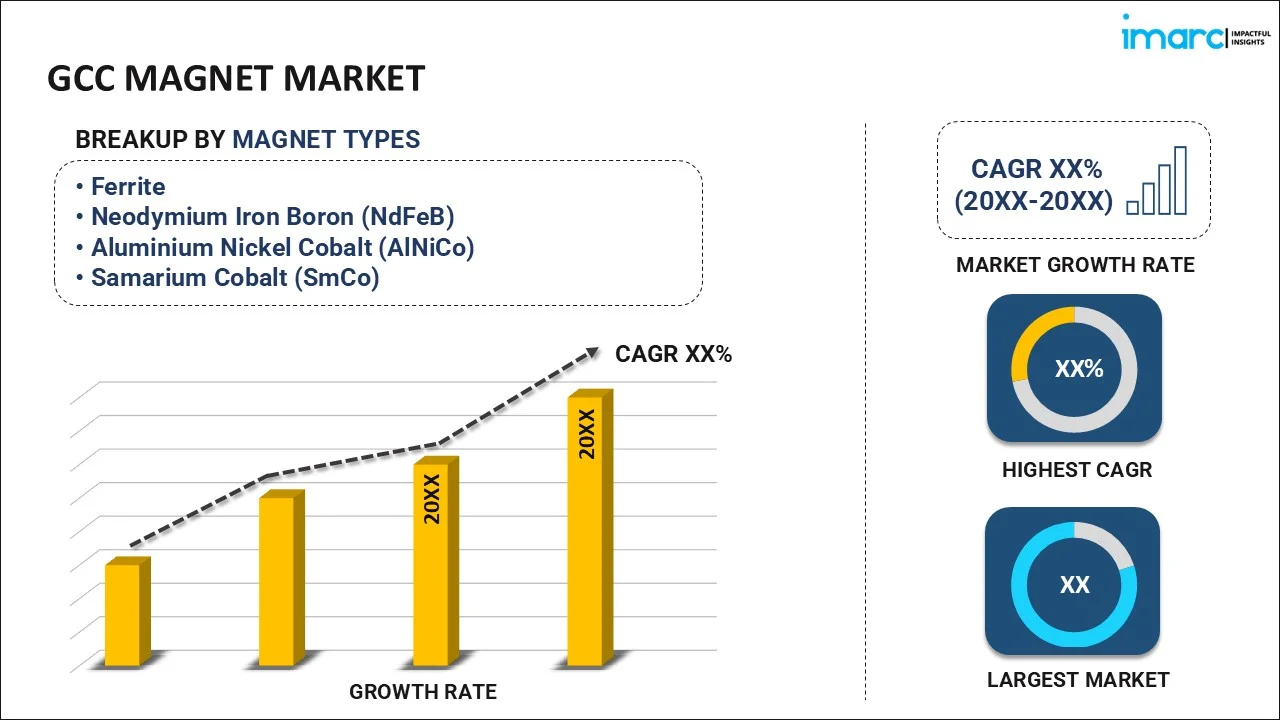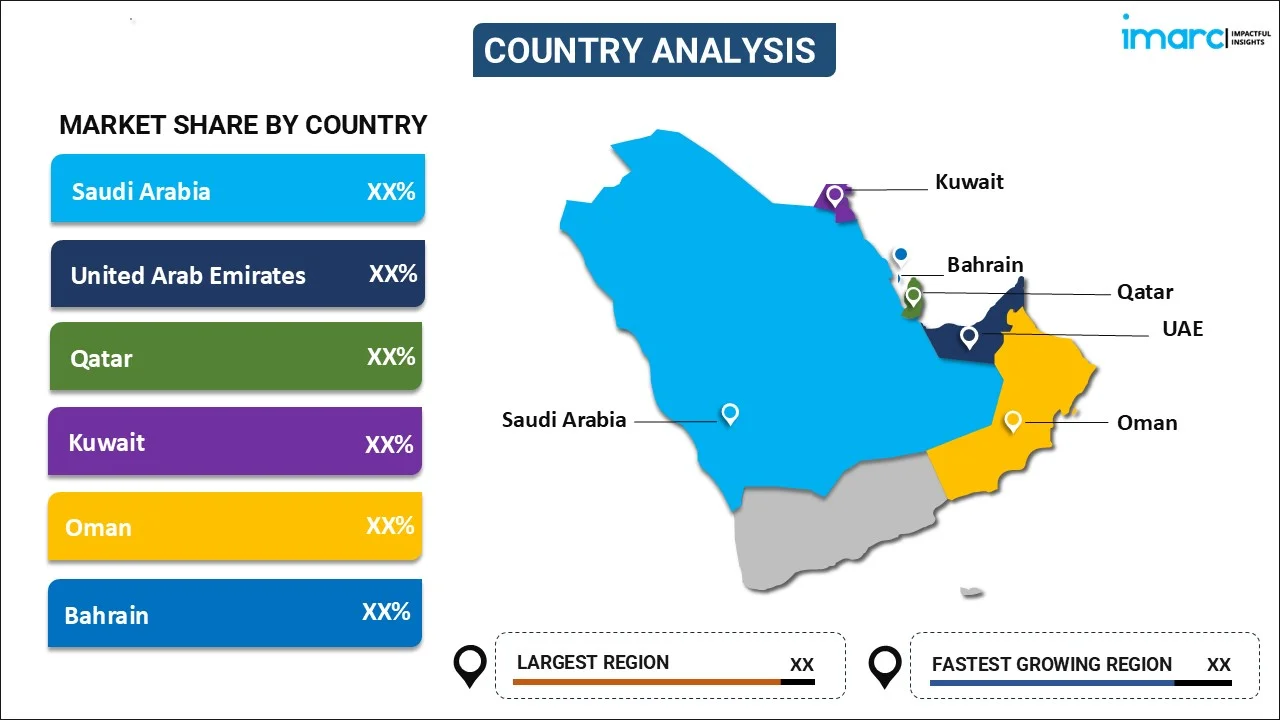
GCC Magnet Market Report by Magnet Type (Ferrite, Neodymium Iron Boron (NdFeB), Aluminium Nickel Cobalt (AlNiCo), Samarium Cobalt (SmCo)), Application (Computer Hard Disk Drives (HDD), CD, DVD, Hybrid Electric Vehicles, Electric Bicycles, Heating, Ventilating and Air Conditioners (HVAC), Wind Turbines, and Others), and Country 2025-2033
Market Overview:
The GCC magnet market size reached USD 800 Million in 2024. Looking forward, IMARC Group expects the market to reach USD 1,460 Million by 2033, exhibiting a growth rate (CAGR) of 6.9% during 2025-2033. The widespread adoption of new technologies, the rising infrastructure projects in several areas, the expanding healthcare sector, the shift toward sustainability, and the widespread adoption of environmentally friendly technologies represent some of the key factors driving the market.
|
Report Attribute
|
Key Statistics
|
|---|---|
|
Base Year
|
2024 |
|
Forecast Years
|
2025-2033
|
|
Historical Years
|
2019-2024
|
| Market Size in 2024 | USD 800 Million |
| Market Forecast in 2033 | USD 1,460 Million |
| Market Growth Rate (2025-2033) | 6.9% |
A magnet is a material or object that produces a magnetic field, a force that pulls on other ferromagnetic materials and attracts or repels other magnets. The Earth itself is a giant magnet, with magnetic poles near the geographic poles. Inside a magnet, the atoms are arranged in such a way that their electrons spin in the same direction. This alignment creates a magnetic force in a specific direction. Magnets are classified into two primary categories: permanent magnets and temporary magnets. Permanent magnets retain their magnetic properties in the absence of an inducing field or current, whereas temporary magnets lose their magnetism when the inducing field is removed. In everyday life, magnets are used in various applications ranging from electronic devices, such as speakers and hard drives, to medical equipment and transportation systems. They play a vital role in modern technology and have numerous industrial and consumer applications due to their ability to generate controlled magnetic fields.
GCC Magnet Market Trends:
Significant technological advancements represent one of the key factors driving the growth of the magnet market across the GCC region. This, coupled with the widespread adoption of new technologies and innovations, such as electric vehicles (EVs) and renewable energy systems that utilize magnets is acting as a major growth-inducing factor. The GCC region is witnessing significant industrial expansion in sectors like automotive, electronics, healthcare, and energy. Magnets are vital in these industries, which is leading to increased demand. In line with this, governments in the GCC region are implementing policies to diversify their economies away from oil dependency. This is leading to investments in various non-oil sectors, which is further facilitating the demand for magnets. The market is also driven by the ongoing infrastructure projects in areas like transportation, construction, and urban development, which are creating demand for magnetic materials. Magnets are used in various applications, including magnetic levitation trains and building systems. In addition to this, the expanding healthcare sector in the region, with increased emphasis on sophisticated medical equipment, is contributing to the growth of the market, as magnets are used in MRI machines and other diagnostic tools. The strategic geographic location of the GCC region provides access to key markets in various regions. This connectivity is enabling the magnet manufacturers in the region to explore export opportunities, which is also contributing to the market growth. Other factors, such as environmental concerns, availability of raw materials, and economic diversification, are creating a positive outlook for the market across the region.
GCC Magnet Market Segmentation:
IMARC Group provides an analysis of the key trends in each segment of the GCC magnet market report, along with forecasts at the regional and country levels for 2025-2033. Our report has categorized the market based on magnet type and application.
Magnet Type Insights:

- Ferrite
- Neodymium Iron Boron (NdFeB)
- Aluminium Nickel Cobalt (AlNiCo)
- Samarium Cobalt (SmCo)
The report has provided a detailed breakup and analysis of the market based on the magnet type. This includes ferrite, neodymium iron boron (NdFeB), aluminium nickel cobalt (AlNiCo), and samarium cobalt (SmCo).
Application Insights:
- Computer Hard Disk Drives (HDD), CD, DVD
- Hybrid Electric Vehicles
- Electric Bicycles
- Heating, Ventilating and Air Conditioners (HVAC)
- Wind Turbines
- Others
A detailed breakup and analysis of the market based on the application has also been provided in the report. This includes computer hard disk drives (HDD), CD, DVD; hybrid electric vehicles; electric bicycles; heating, ventilating and air conditioners (HVAC); wind turbines; and others.
Country Insights:

- Saudi Arabia
- UAE
- Qatar
- Oman
- Kuwait
- Bahrain
The report has also provided a comprehensive analysis of all the major regional markets, which include Saudi Arabia, the UAE, Qatar, Oman, Kuwait, and Bahrain.
Competitive Landscape:
The report has also provided a comprehensive analysis of the competitive landscape in the GCC magnet market. Competitive analysis such as market structure, key player positioning, top winning strategies, competitive dashboard, and company evaluation quadrant has been covered in the report. Also, detailed profiles of all major companies have been provided.
GCC Magnet Market Report Coverage:
| Report Features | Details |
|---|---|
| Base Year of the Analysis | 2024 |
| Historical Period | 2019-2024 |
| Forecast Period | 2025-2033 |
| Units | Million USD |
| Scope of the Report | Exploration of Historical and Forecast Trends, Industry Catalysts and Challenges, Segment-Wise Historical and Predictive Market Assessment:
|
| Magnet Types Covered | Ferrite, Neodymium Iron Boron (NdFeB), Aluminium Nickel Cobalt (AlNiCo), Samarium Cobalt (SmCo) |
| Applications Covered | Computer Hard Disk Drives (HDD), CD, DVD, Hybrid Electric Vehicles, Electric Bicycles, Heating, Ventilating and Air Conditioners (HVAC), Wind Turbines, Others |
| Countries Covered | Saudi Arabia, UAE, Qatar, Oman, Kuwait, Bahrain |
| Customization Scope | 10% Free Customization |
| Post-Sale Analyst Support | 10-12 Weeks |
| Delivery Format | PDF and Excel through Email (We can also provide the editable version of the report in PPT/Word format on special request) |
Key Questions Answered in This Report:
- How has the GCC magnet market performed so far and how will it perform in the coming years?
- What has been the impact of COVID-19 on the GCC magnet market?
- What is the breakup of the GCC magnet market on the basis of magnet type?
- What is the breakup of the GCC magnet market on the basis of application?
- What are the various stages in the value chain of the GCC magnet market?
- What are the key driving factors and challenges in the GCC magnet market?
- What is the structure of the GCC magnet market and who are the key players?
- What is the degree of competition in the GCC magnet market?
Key Benefits for Stakeholders:
- IMARC’s report offers a comprehensive quantitative analysis of various market segments, historical and current market trends, market forecasts, and dynamics of the GCC magnet market from 2019-2033.
- The research study provides the latest information on the market drivers, challenges, and opportunities in the GCC magnet market.
- Porter's five forces analysis assist stakeholders in assessing the impact of new entrants, competitive rivalry, supplier power, buyer power, and the threat of substitution. It helps stakeholders to analyze the level of competition within the GCC magnet industry and its attractiveness.
- Competitive landscape allows stakeholders to understand their competitive environment and provides an insight into the current positions of key players in the market.
Need more help?
- Speak to our experienced analysts for insights on the current market scenarios.
- Include additional segments and countries to customize the report as per your requirement.
- Gain an unparalleled competitive advantage in your domain by understanding how to utilize the report and positively impacting your operations and revenue.
- For further assistance, please connect with our analysts.
 Inquire Before Buying
Inquire Before Buying
 Speak to an Analyst
Speak to an Analyst
 Request Brochure
Request Brochure
 Request Customization
Request Customization




.webp)




.webp)












